Have you ever opened a cookbook, or read a recipe online and felt as though you were reading something in a different language? Well, in some ways you were. Cooking does have a specific vocabulary associated with it. If you don’t understand that vocabulary you are already at a disadvantage. For example, if you don’t know what it means to “sauté”, “reduce by half”, or “julienne”, how can you accurately follow a recipe that includes those terms? Obviously you can’t.
Today is the launch of my free 10-week basic cooking course “Kitchen Clueless to Food Independent“. As it is the beginning we will be starting in what appears to me to be the most logical place, cooking terms. It seems to me that if you don’t understand what I’m saying you aren’t going to learn too much. So please join me as we define some of the most used and most important cooking terms you will come across in the course and beyond.
And with that, let’s take a look at…
Understanding Cooking Terms
My Basic Cooking Course Week 1
Terms
Bake
To bake or baking means to cook something with dry, indirect heat as in an oven. An example of cooking over direct heat would be cooking over a flame. Typically baking is done with a moderate heat between 300°F – 375°F. Foods that would typically be baked include cakes, cookies, and bread.
Blanch
To blanch or blanching can mean two things. When referring to French Fries it means to partially cook in oil at a temperature of 300°F – 340°F. This blanching process cooks the fries through. The second and final cooking process is done on a higher heat 350°F – 375°F and crisps the outside of the fries. Without this initial blanching, the French Fries would get a very dark almost burnt colour on the outside in the amount of time it would take to cook them through.
The second meaning of blanching or to blanch is the more commonly used one. It means to place a food item in boiling water for a few seconds to a few minutes. The food item is then removed from the boiling water and placed in ice water to stop the cooking process.
This blanching process is used most commonly to peel tomatoes. A small cross cut is made on the bottom of the tomato which is then processed as described above. Once the tomato comes out of the ice water the peel comes off very easily. Two other uses for this process include helping to keep the vibrant green colour of basil when making pesto. And, for processing fresh vegetables prior to freezing them.
Braise
Braising is a moist-heat cooking method most commonly used for cooking meat. Braising is typically done at low temperatures over long periods of time. It is usually combined with a secondary cooking method such as searing or grilling.
The food item being braised is usually first seared in a hot pan to colour its outside and add flavour. Liquid such as wine, stock, or water is then added along with other flavourings. A lid is placed on the pot which is then placed in an oven preheated to a temperature between 275°F – 325°F.
Braising is a cooking method best suited to larger and tougher cuts of meat. Stewing is braising that is usually done on the stovetop rather than in an oven.
Brine
A brine is a salt and water solution most typically used to make fermented pickles and sauerkraut.
Today it is common to brine ribs, turkey, and chickens. These types of brine usually contain sugar along with salt, water and other flavourings. The benefit of bringing certain meat items is that the salt absorbs into the meat and binds with the protein molecules. This helps the meat retain moisture when cooked and also adds flavour.
Boil
Boiling is the point at which a liquid is heated so that it is vigorously bubbling. Boiling is used mostly to cook pasta, potatoes, and some vegetables. It can also be used for the processes of reduction and steaming. When meat, fish, vegetables or dumplings are set above boiling water and covered they are cooked by the steam evaporating off the surface of the boiling water.
Meats should not be boiled as the high heat and vigorous movement can toughen the protein strands, and make the meat rubbery. The term “boiled eggs” is a misnomer as eggs develop a sulfury smell and taste when subjected to the high heat of boiling. There is also the potential for the shells to break from the vigorous movement. Most other foods don’t do well when boiled. They tend to toughen, overcook, loose colour and flavour, and/or fall apart.
Broil
To broil is to cook something quickly over a very hot direct heat source. Most ovens have a broil setting that activates the top element in the oven which reaches temperatures in excess of 500°F. Broiling is most often down to melt cheese or quickly brown foods. It can also be used to cook steaks or pork chops.
Brown
Browning, also known as the Maillard reaction is the process by which amino acids and sugars present in food interact with heat and change colour and flavour. Think about browning a steak or the brown spots on the cheese and crust of a pizza. See caramelize (caramelization)
Caramelize
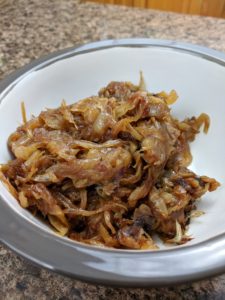
Caramelization is the process of oxidizing sugar using heat. We’ve all had caramel which is just refined sugar heat to the point of almost burning. Most foods, vegetables especially have natural sugars that when caramelized provide a deep flavour with a mild sweetness. Think of caramelized onions. This caramelization is also present in roasted vegetables to a lesser degree.
Caramelized onions are cooked over a low temperature for a fairly long amount of time. This low and slow cooking process draws the natural sugars out of the onion and the oxidizes them giving the onions a deep caramel brown colour and a sweet flavour.
Clarify
The term ” to clarify” means “to make clear” or to remove any solids and sediment from a liquid. In cooking it usually refers to either clarified butter or stock.
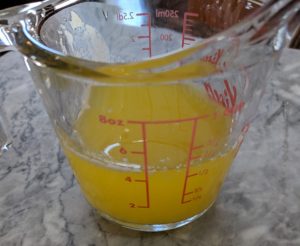
In the case of butter, it is first melted and left to sit for a few minutes. During that time the butterfat will separate from the milk solids. The butterfat, a golden coloured liquid will be sandwiched between two layers of cloudy white solids. The top layer of solids is carefully scooped off and discarded. The butterfat is then scooped out and saved leaving only the remaining milk solids on the bottom of the dish. For very clear clarified butter, the butterfat is then strained through cheesecloth.
Chop
To chop is to cut into small pieces with a vigorous cutting motion. This is usually only used for certain herbs like parsley or for very finely chopped meat such as for steak tartare.
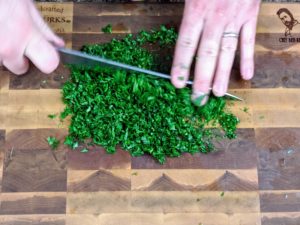
When chopping, one hand holds the handle of the knife in a firm but a comfortable grip. The other hand is placed either on the back of the blade of the knife roughly 1/3 of the way from the tip of the blade to the handle. This will create a counterbalancing point and allow the knife to chop most efficiently.
Conventional Oven
A conventional oven is one that is heated either by burning gas, or electric elements from the top, bottom or both. The temperature is controlled by a thermometer attached to an on-off switch which turns the elements or gas on or off based on the set temperature.
Convection Oven
A convection oven is similar to a conventional oven but with the addition of a fan to circulate heated air. Convection ovens are generally more efficient. Typically, when using a convection oven the temperature is set 15°-25° lower than for a conventional oven. In modern convection ovens, this temperature change is automatic.
Higher-end convection ovens generally have three settings, Convect-Bake, Convect-Roast, and Convect-Broil. The convect-bake setting heats from the bottom. The convect-roast setting heats from the top element. The convect-broil setting heats from the top element as well but on a much higher temperature.
Cup
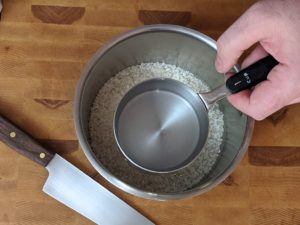
A cup is a standardized unit of volume measure that is described as both 250 ml and 240 ml. In the metric system 1 cup = 250 ml, while in the US 1 cup usually = 240 ml. For most things, this difference won’t have much of an effect. However, for baking, it is important to note which cup you are supposed to be using. (that’s why baking is best done by weight rather than volume).
A cup can be broken down into 1/2, 1/3 and 1/4 cups.
For accurate measuring buy good quality measuring cups with cleary written measurements.
Deep Fry
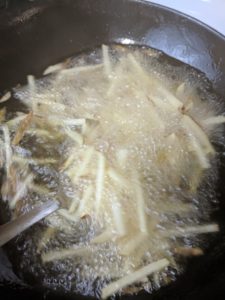
To deep fry is to cook foods completely submerged in hot oil. The temperature range for deep frying oil generally falls between 325°F and 375°f. Canola oil, lard, duck fat, and peanut oil are the fats most commonly used for deep frying due to their high smoke point.
When deep-frying it is important that the oil is up to temperature prior to the food being added. Food added to oil that has not reached a proper cooking temperature may absorb large amounts of oil and be overly greasy.
Deglaze
To deglaze means to add liquid, generally alcohol such as wine, to a hot pan to release bits of food that have become stuck to its surface. This is typically done when making a pan sauce or gravy. It is important that the pan be hot when the liquid is added otherwise the stuck food bits won’t lift up as easily.
Demiglace (or just demi)
Demiglacce means half glave in french. Essentially, it is a thick brown sauce made of thickened stock. The stock is traditionally thickened with a roux however it is also common to thicken the stock using natural gelatin. Demiglace can be used as a sauce by itself or added to pan sauces to create a secondary sauce.
Dice
To dice is to cut food into small cubes. There are four main sizes of dice. A fine dice, also known as a brunoise is usually around 3 mm x 3 mm x 3mm. A small dice is usually 6 mm x 6mm x 6mm. A medium diced is generally 9 mm x 9mm x 9mm. And a large dice is 1 cm x 1 cm x 1 cm.
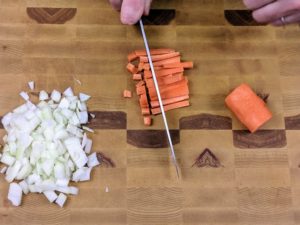
Foods that are to be diced are typically first cut into slabs or boards, then into sticks, or matchsticks the same dimension of the diced cubes. Then the matchsticks are lined up and cut across to make the final dice. The bigger the dice the bigger the matchsticks.
Dry Roast
To dry roast is very similar to baking but usually done on a higher heat between 375°f and 450°F. The “dry” in dry roasting typically means that no fat or liquid is added to the food item being roasted. Dry roasting is typically used when roasting nuts, seeds, or coffee beans.
Emulsify
To emulsify or emulsification is the act of combining two liquids that typically don’t mix (water and oil). Examples of common emulsifications include mayonnaise, chocolate, hollandaise sauce, and vinaigrettes.
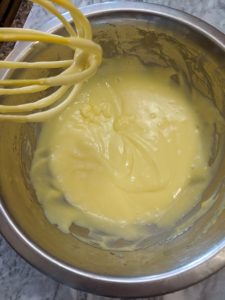
To make an emulsification a binder is typically used. The binders help hold together the two liquids that don’t want to hold together. In the case of mayonnaise and hollandaise sauce, the binder is the egg yolk. When making a vinaigrette the binder is typically mustard either prepared or dried.
Fillet
A fillet is a boneless cut of meat or fish. In Europe, a fillet of beef refers to beef tenderloin.
Garnish
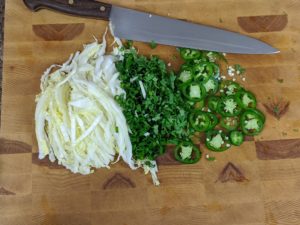
Garnish can refer to something added to a dish for presentation purposes such as edible flowers or curly parsley. It can also refer to a series of ingredients added to a broth-based soup or pizza. In pho, for example, the garnish could refer to the cilantro and Thai basil and/or the other vegetables present in the soup.
Glaze
A glaze in cooking is a thick, usually sweet sauce, that is added to foods during the cooking process. Often the glaze will add shine to the food item. Carrots are often glazed with a little honey and vinegar or brown sugar and butter.
Gram
A gram is a small unit of measure in the metric system weighing approximately the same as 1 cubic centimetre of water. For conversion to the American system, 1 oz equals roughly 28 g.
Grill
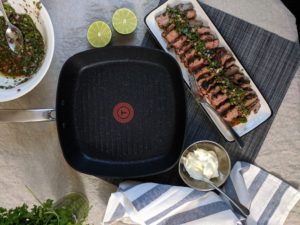
To grill (grilled) is typically synonymous with barbecuing as referred to in Canada. However, food cooked in a grill pan, over an indoor electric or gas grill, can also be called grilled.
Gratin
Gratin can be either a crust of melted cheese and bread crumbs or the process of melting and browning the cheese. The most common use of the term is potatoes au gratin which is a dish of thinly sliced potatoes cooked in cream and topped with cheese that is melted under a broiler (gratin).
Julienne
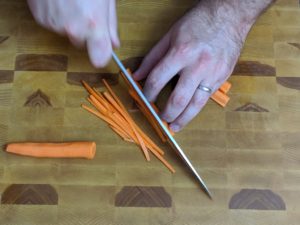
Julienne is a type of cut where the food item is cut into matchstick. The size of the matchstick can vary from 3×3 mm to 1 x 1 cm. Julienne bigger than 1 x 1 cm and the julienne is known as a batonnet. A similar style of cut used for soft herbs is known as a chiffonade. For a chiffonade, the herbs are rolled or stacked and cut into long thin strips.
Kilogram
A kilogram (also known as a kilo or kg) is a unit of measure in the metric system weighing approximately the same as 1 Litre of water. 1 kilogram equals 1000 grams. For conversion to the American system, 1 kg = approx. 2.2 lbs.
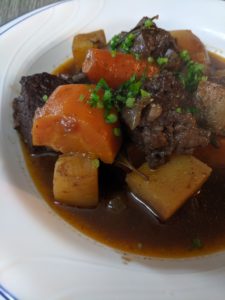
Low and Slow
Low and slow is a term in common use referring to a style of cooking on low heat for a long period of time. Braising, smoking, and “slow cooking” all fall under low and slow.
Litre
A litre (L) is a unit of liquid measure in the metric system comprised of 1000 millilitres, 4 metric cups, or approx. 2 pints. For US conversion 1 L = approx. 32 fl oz.
Marinade/Marinate
A marinade is a strongly flavoured liquid used to tenderize and flavour meat, fish, and poultry. A marinade differs from brine in that it generally contains an acid such as vinegar, oil, and spices a brine is a saltwater solution.
To marinate food, the marinade ingredients are combined and the food being marinated is added and left to sit over a period of time. The food item is then removed from the marinade and cooked as desired. Some marinades are than pasteurized by boiling and used as a sauce or a glaze.
Mother Sauces
In French cooking, there are five base sauces known as the mother sauces. Other ingredients are added to these base sauces to create an unlimited array of secondary sauces. The mother sauces are Hollandaise, Tomato, Espagnole, Veloute, Bechamel.
Béarnaise sauce is made by steeping shallots, tarragon, and often peppercorns in vinegar. The resulting liquid is used in place of lemon juice in Hollandaise. In this case, Hollandaise would be the mother sauce and Béarnaise sauce would be the secondary sauce.
Mince
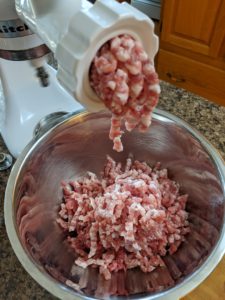
Mince can refer to ground or very finely chopped meat. Most commonly the word Mince refers to food items that have been cut very, very small or the act of cutting food very small. It is an imprecise term that has no specific measurements associated with it.
Mirepoix
Mirepoix is a combination of 2 parts onions, 1 part each celery and carrot. This combination is used extensively in French cooking to flavour soups and sauces. In Italian, this combination is known as soffritto not to be confused with Spanish and Portuguese sofrito which is a combination of onion, tomato, garlic and pepper.
Pan-Fry
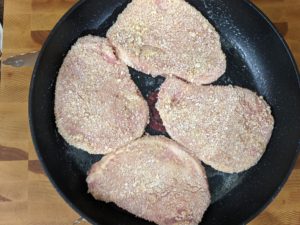
Pan-fry can mean to either cook in a shallow pan on the stovetop in a small amount of oil over moderate heat. It is often used as an interchangeable term for sautéeing however pan-fried items are oven coated in bread crumbs or flour prior to cooking. Pan-frying differs from shallow-frying in that much less oil is used to pan-fry generally only 1-2 tbsp.
The style of cooking is most commonly used for cooking fish such as haddock, cod or trout.
Pinch
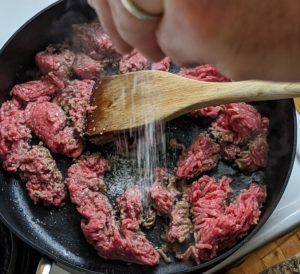
Often in recipes, you will be told to “add a pinch of salt” or “a pinch of cinnamon”. A pinch is an amount you can pick up between the ends of your thumb and index finger. In the case of salt, you would reach your thumb and index finger into the salt dish (best not to use a shaker), and pinch your fingers together. The amount of salt between those two fingers is a pinch. and you have a pinch of salt. Occasionally the middle finger may be included in the pinch though this won’t drastically increase the amount of salt that is picked up.
Poach (poached, poaching)
To poach is to cook in simmering water. This style of cooking is most typically used for eggs and fish. It is important when poaching that the water is not boiling. The water should be hardly moving. Because the foods most commonly poached are fragile, the vigorous motion of boiling will break the food. Also, the high-heat of boiling can have a negative effect on the texture of foods.
Poaching can be done in plain water, flavoured water, olive oil, beer, or wine.
Reduce
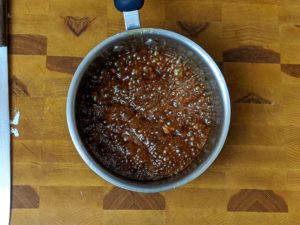
It is not uncommon to be told to “reduce by half” or “reduce by two thirds” in a recipe. This is referring to the amount of liquid that has evaporated from the overall volume.
A recipe that tells you to “add 1 cup of wine then reduce by half” is saying to cook the wine until the total volume is half as much as you initially added. In this case, the total amount of wine left in the pan should be about a 1/2 cup.
Reducing liquids has two main purposes. First and foremost it concentrates the flavour. Water evaporates but the flavour stays behind. The more water you take out the more intense the flavour will be. The second purpose is to thicken. The more water you take out of a substance the thicker it will be.
Render (rendering)
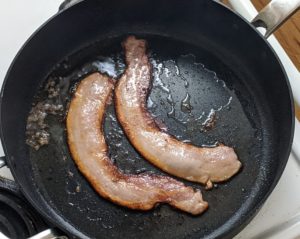
Rendering is the process of slowly melting fat out of a food item. When cooking bacon it is common to start it in a cold pan. The pan and the bacon heat at roughly the same rate. This slow heating allows the fat in the bacon to melt away or render from the bacon. The bacon then cooks in this fat and gets very crispy.
You may also see this term when talking about cooking duck breasts. Duck skin is very fatty but very flavourful. To make it palatable some of the fat has to be rendered out.
Roast
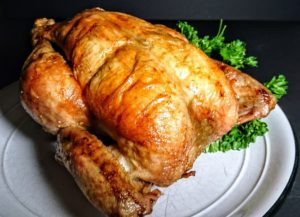
Roasting traditionally refers to cooking in front of a flame over a long period of time. Today it is more commonly used to refer to baking meat on high heat between 375°F – 450°f. Modern ovens will have a “roast” setting which turns on the top element of the oven rather than the bottom element. This creates a nice crust or “roasted” appearance on the surface of the meat.
Roasting is a technique most commonly used for large cuts of meat such as hams, legs of lamb, or big pieces of beef. It is also common to roast vegetables. Roasted vegetables take on a mildly sweet flavour that highlights their natural flavours.
Roux
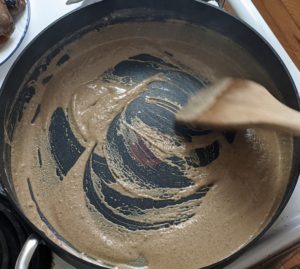
A roux is a mixture of equal parts (by weight) of flour and fat (most commonly butter) used to thicken soups and sauces.
To make a roux the fat is first melted then the flour is added. This mixture is cooked for 2-35 minutes depending on how dark a roux is desired. The darker the roux the nuttier the flavour. Light roux (cooked for 2-5 minutes) are the most common. Very dark roux is generally used to make Gumbo.
The general rule for adding a roux to a soup or sauce is that cold liquid should be added to a hot roux and a cold roux should be added to hot liquids. If this is done in reverse the risk of lumps increases dramatically.
Sauté
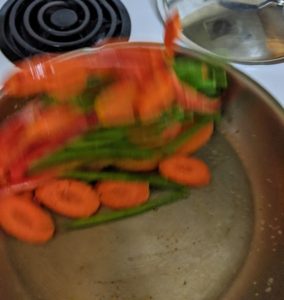
In French satué means to jump, that is the best way to describe this cooking technique. Food is added to a hot frying pan with a small amount of fat and cooked quickly while being tossed or stirred. The food is almost constantly kept in motion to prevent burning due to the high cooking temperature. This technique is most commonly used for vegetables.
Score
To score is to make small shallow cuts into a food item. This can be done to the bottom of a tomato that is going to be balanced and peeled. It can also be done to pork or duck skin to allow a marinade to penetrate more deeply, to create a nice presentation, or to allow for skin and fat to become crisper during cooking.
Sear (sealing)
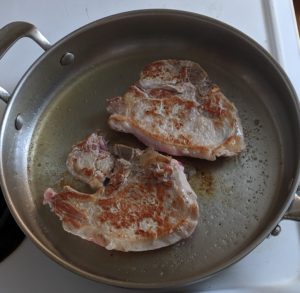
Searing used to be called sealing because it was believed that the process sealed in moisture and flavour. This is false. Searing is done in a pan over very high heat with little to no fat. The purpose is to brown the surface of the meat, poultry, or fish very quickly. This browning adds a dept to the flavour that would otherwise not be there. This technique can be used on its own but is more commonly combined with braising.
When making a beef stew it is common to sear or brown the beef before adding it into the gravy to be braised.
Season (seasoning)
You will see time and time again in recipes to “season to taste” the seasoning being referred to is salt and pepper unless otherwise specified. The “to taste” part of that just means to add salt and pepper until you think it tastes good enough.
Shred (shredded/grated)
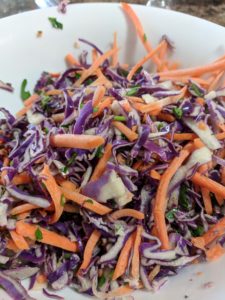
To shred or shredded usually refers to cabbage or lettuce that has either been cut very thinly or that has been grated on a cheese grater. Shredded cabbage can most commonly be found in coleslaw while shredded lettuce is most commonly used as a topping for hamburgers.
Simmer
To simmer is to cook a liquid on low heat. Usually, this item has been brought to boil first then the heat was turned down and the boil stops and turns into a simmer. Where a boil is violently churring liquid, a simmer is a very calm bubbling liquid.
Simmering is a way to cook liquids over a long period of time to intensify the flavour and to thicken. You simmer a pasta sauce or pot of chilli.
Skim
Skim can refer to a type of milk that has had the majority of fat emoved or skimmed off the top. It can also refer to the process of removing any scum that has accumulated at the top of a stockpot. Skimming a stock helps to ensure a clear appearance and flavour.
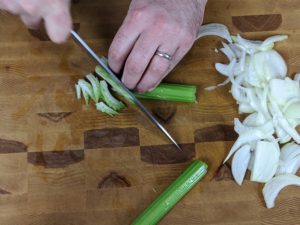
Slice
A slice is a thin, broad cut of food. Think a slice of cheese, tomato or bread. This type of cut can be used to cut vegetables such as onions, carrots, celery, and cabbage, as well as meats like roast beef or chicken. Slice is a fairly broad term used commonly to just mean cut.
Steam
Steam is water in its gaseous form. Water has a boiling point of 212°F any temperature above that and the water becomes steam. Because steam is hotter than water is can be used to cook foods quicker and more efficiently than boiling or simmering water. Because foods that are steamed are not submerged in water then retain more of their nutritional value.
Food that is to be steamed is placed in a sealed basket above boiling water. The steam collects in the sealed basket and cooks the food. I like to think of steaming as water smoking. Where smoking is cooking food with vapour from superheated wood, steaming is cooking food with vapour from superheated water.
Stew
A stew is a food item generally containing meat and vegetables cooked in a thickened stock or gravy.
Stewed fruit and vegetables are generally cooked in a small amount of water that has been thickened with flour, cornstarch, or reduction like stewed tomatoes.
Stock (Broth)
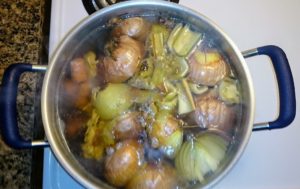
A stock is a flavoured liquid made by simmering bones with vegetables and herbs. This liquid is strained and used as the base liquid for soups, braises, and sauces, or to cook rice or potatoes.
Today the term bone broth gets thrown around a lot but this isn’t actually a thing. Where stock is made by simmering bones a broth is made by simmering meat. They are two very distinct things with different uses. Stock is used as a base of other foods but would never be served on its own. A broth, on the other hand, is served on its own as a soup.
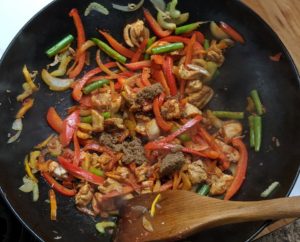
Stir-Fry
Stir-fry can refer to both a style of cooking and a style of food. The style of cooking is the Asian equivalent to sauté. The difference is that a stir-fry is most typically cooked in a wok where a sauté is done in a regular frying pan. The food stir-fry is a combination of meat and vegetables that have been cooked using the stir-fry technique.
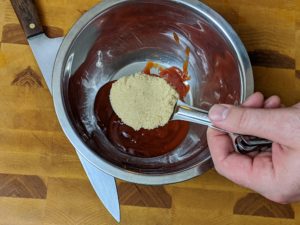
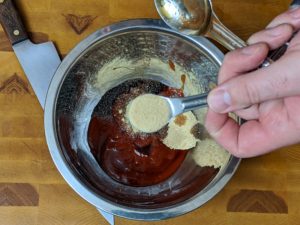
Tablespoon/Teaspoon
A tablespoon (tbsp) is a unit of volume measure. In the metric system 1 tbsp = exactly 15 ml. In the US system 1 tbsp = 14.8 ml. Strangely enough in Australia 1 tbsp = 20 ml. 4 metric tbsp = 1/4 cup
A teaspoon (tsp) is also a unit of volume measure. 3 tsp = 1 tbsp. In the metric system 1 tsp = 5 ml. In the US system 1 tsp = 4.92 ml. Oddly enough an Australian tsp is the same as a metric tsp.
The differences in these measurements from place to place are small but it is important to note where the recipe is coming from especially if you are multiplying the recipe. Small differences become large ones on a certain scale.
Temper (tempering)
To temper or tempering is the process of slowly adding a hot liquid to a cooler liquid to slowly increase the temperature. The process is generally used with items containing a high portion of egg or an item that may curdle. The idea is that by gradually increasing the temperature of the potentially volatile item it is less likely to curdle.
This process is used for lots of recipes but is best illustrated when making a chocolate mousse. Egg yolk and sugar is beaten together while chocolate is melted with rum and espresso. The chocolate mixture is considerably hotter than the egg yolk mixture. Because of this temperature difference adding all the chocolate at once would solidify the egg yolk leaving little bits of cooked egg yolk in the mousse. Instead, if the hot chocolate is whisked into the egg yolk in a slow steady stream the temperature will gradually increase, and the egg yolk won’t cook in the same way. What could have been a lumpy gross mess is instead smooth and delicious.
Tempering has a second meaning and is used to refer to chocolate that has been tempered in order to have it set firm, shiny, and with a nice cracking sound when broken. This is done by melting chocolate at one temperature, adding unmelted chocolate to lower the temperature and then slightly raising the temperature. These temperature changes cause the cocoa butter in the chocolate to harden into a specific crystalline pattern. This pattern is what gives tempered chocolate its texture and appearance.
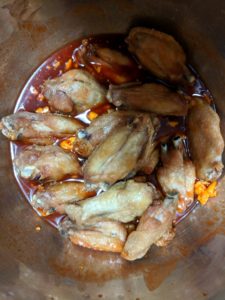
Toss
To toss is to flip and jostle food in a bowl or pan in order to evenly distribute a sauce or another ingredient. You may toss cooked French Fries in a bowl with salt to evenly coat the fries with the seasoning.
Tossing a pan refers to a push and pull motion of a pan which causes the food to flip forward and back down on itself. Professional chefs use this technique rather than stirring because it is quicker and in many ways more efficient.
Truss
To truss is to tie a food item, often poultry, or meat to be roasted. When trussing a chicken the legs and wings are brought tight to the body in order to ensure a more even cook.
Next week…
Come back next Wednesday for Week 2 of my free basic cooking course when we look at and define basic cooking equipment. Remember to subscribe to the blog so you never miss a post and please share this post with anyone you know who needs a little help in the kitchen.
If there are any terms you are unsure of that I didn’t include on this list please mention it in the comments. I will define it for you and it will likely help other people too.
Thanks as always for reading and taking part in the course. See you Friday!

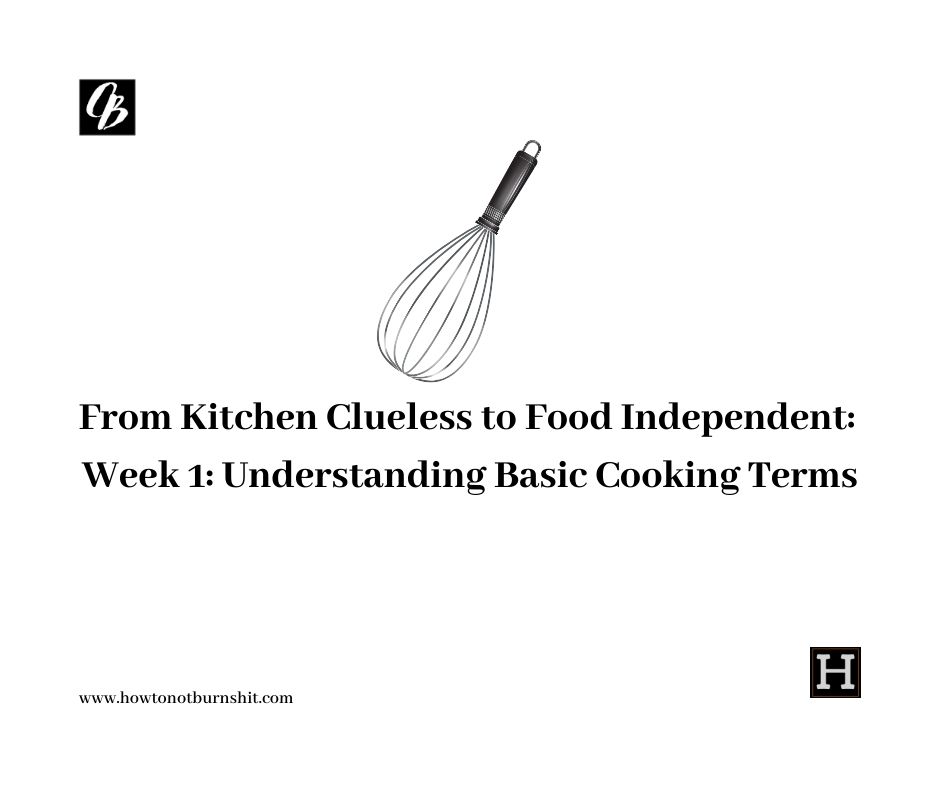
0 Comments
Trackbacks/Pingbacks